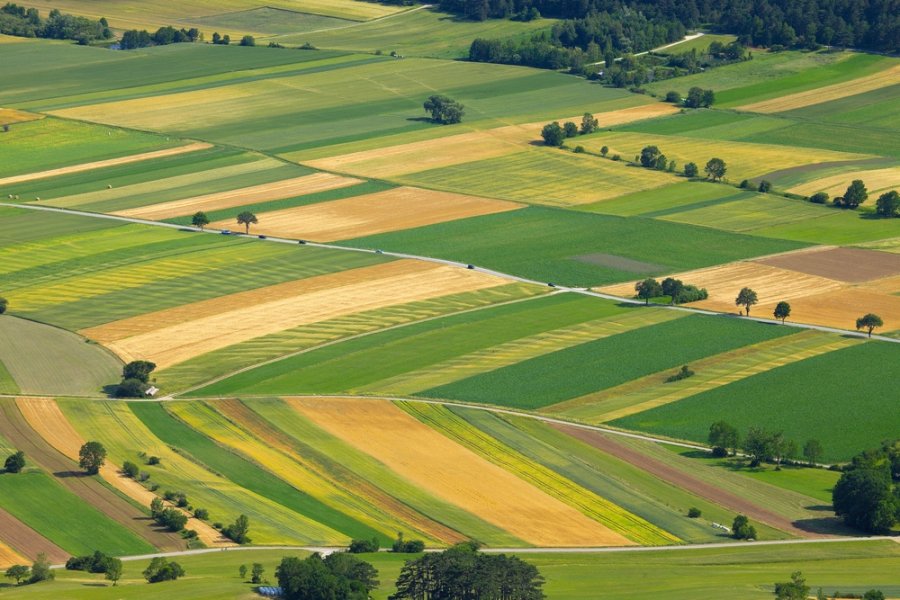
How big is 100 acres of land and what does 100 acres look like? So, you’re considering buying a piece of land with 100 acres on it, but you’re trying to visualize just how big that is. Fortunately, you’ve come to the right place.
After all, unless you’re going to keep your lot wooded for some privacy and seclusion and you don’t really care exactly how big it is, it’s good to have a reference point when you think about those 100 acres.
One hundred acres is indeed a lot of land, and since most of these lots are out in the country, the per-acre prices are usually pretty low.
Nevertheless, when you start visualizing in your mind what 100 acres actually looks like, it’s good to have a few things to compare it to so you know what you’re buying.
How Big Is 100 Acres Of Land? (What Does 100 Acres Look Like?)
If you’re curious about how big 100 acres is, consider the following statistics about this much land.
- It is the size of 1500 tennis courts
- It is the size of 130 football fields
- It is the size of 15,600 parking spaces.
- It is the size of 1800 average-sized homes
- It is roughly the size of the Mall of America, which is 96 acres
- It is 3-1/2 times the size of Ellis Island, which covers 27.4 acres
- It is 9/10 the size of Vatican City, which covers 110 acres
- It is 4-1/2 times the size of Alcatraz, which covers 22 acres
- It is 3/5 the size of Disneyland at 160 acres
- It is 1/5 the size of Monaco, which covers 500 acres
- It is 1-4/5 times the size of the U.S. Capitol, which covers 57 acres
- It is 5-1/2 times the size of Buckingham Palace, which covers 19 acres
- It is twice the size of Grand Central Station, which covers 50 acres
- It is eight times the size of a polo field, which has roughly 12.4 acres of playing area
- It is three times larger than the Pentagon, which covers 34.1 acres
- It is 1/10 the size of Central Park, which consists of a whopping 843 acres
- It is 13 times bigger than the Lincoln Memorial Reflecting Pool, which sits on roughly 7.8 acres
- It is 65 times bigger than the White House, which is home to 1.5 acres of floor space
- It is 250 times bigger than a hockey rink, which only covers about .37 acres
- It is 800 times bigger than a basketball court, which only covers around .12 acres
One hundred acres covers 4,356,000 square feet, so it is quite massive. If you want to turn the property into some hunting land, it can be a little expensive, but it’ll likely be productive in the end. Other things that you can do with a 100-acre lot include:
- Rent plots to various groups wanting to build community gardens
- Sell plant seeds of various types online
- Create fishing ponds or lakes that can be rented by local groups or fishermen
- Start a blog about your newest farming adventures
To be sure, if you want to turn the land into farming land, you have a lot of products to choose from because you can use it to breed animals, plant fruits and vegetables, raise cattle or goats, or even start a honey-making facility.
How Much Will You Pay for a 100-Acre Lot?
This question is difficult to answer because the prices vary a lot depending on where you live, where the lot is located, and whether it’s developed or undeveloped land.
Undeveloped land, on average, is around $6500 per acre, while farmland can be as cheap as $2000 per acre. At the other end of the spectrum is developed land, which is land where roads, housing, and other structures are located.
This type of land averages $106,000 per acre, but again, these prices are very much loose estimates because there are so many different factors that affect the per-acre price of a piece of land.
How Many Acres Are in a Lot?
One acre equals 43,560 square feet, and a lot that measures 2 feet by 3 feet is the equivalent of 6 square feet. So, you have to figure out how many times 6 goes into 43,560, and the answer to that is 7260. (??)
This rule just describes how to calculate how many acres are in a lot. Different lots can be different sizes, and once you determine the exact size of the lot you’re talking about, you can easily answer the question of how many acres are in a lot.
How to Determine the Amount Your Land is Worth
The first thing you’ll need to do is determine the exact value of your land, or at least a very close estimate. You can get the assessed value from the clerk of court’s office and the appraised value from a realtor.
Then you’ll need to subtract the depreciation cost of each building from the replacement cost. Once you get that amount, you’ll add the adjusted value of all of the buildings together, then add that total to the estimated land value.
This is called the cost approach appraisal method of determining what your land is worth, but there are other ways to calculate this number as well. Ask an accountant if you need assistance in this area.
Where Can I Buy the Cheapest Land?
If your dream is to move somewhere and buy 100 acres of land but you’re not made out of money, there is good news. Many cities across the United States offer very cheap prices for an acre of land, and a lot of those places offer incentives as well.
In Gerlach, Nevada, for example, it is possible to buy land for as little as $157 per acre. In states such as Arkansas, Tennessee, and West Virginia, prices are consistently lower than in all of the other states if residential land is what you’re looking for.
And if you’re interested in Tennessee specifically, their diverse geography enables you to find land that is rural and flat, land that is mountainous and hilly, and even land close to iconic places such as Graceland in Memphis and Nashville, where the heart of country music is located.
Maine is another state to look at when you want land at a cheap price. Their prices are reasonable for numerous reasons.
First of all, Maine is the most forested state in the U.S., which means that there’s plenty of undeveloped land — which is always cheaper — for people to buy.
Next, many people simply don’t want to live in a place that gets that cold, so the state, while beautiful, offers these low prices to attract people who love the country.
Of course, if you’re interested in turning your land into a farm, just know that the average construction costs average around $25 per square foot.
This can add up quickly, but again, there are ways to lower that amount if you do your due diligence and study the area that you’re considering buying land in.
Other Things That You Can Do with 100 Acres of Land
Other things you can do with your new 100-acre property include the following:
- Use it as an RV storage area and charge travelers who need to stop and rest for a night or two
- Chop firewood and sell the firewood to people and businesses
- Have a roadside farm stand with fruits, veggies, or herbs that you grow on the property
- Use it as a campground that people can lease from you
- Use it as either a solar energy or wind energy farm
- Use it as a produce farm and allow people to come pick their own produce
- Use it as a boat storage place and charge people to store their boats there
The only thing that you’ll need to do for any of these ideas is check with authorities to make sure that you get all of the necessary permissions and permits before you start converting your land into some type of business.
Of course, you can also keep your land wooded and simply enjoy the peace and serenity of country life. You won’t make any money this way, but you’ll have the satisfaction of knowing that you can enjoy a quiet and peaceful life any time you like.
Conclusion
Visualizing what 100 acres looks like isn’t that difficult if you have a few things to compare them to. A 100-acre lot can be a great way to enjoy a more serene lifestyle, and one thing to remember is that 100 acres is a lot of land regardless of who you are or what you plan to use it for.
If you live in an area that is growing and becoming larger, keeping your property undeveloped can be a great way to cushion yourself from that growth.
Whatever you wish to do with your hundred acres, you can usually do it, and doing some research ahead of time is smart because the last thing you want is to buy a huge piece of property and then discover that you can’t do with it what you wanted to do.
